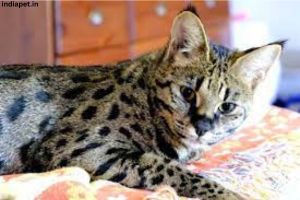Cats with Pointy Ears
A feline’s ears are highly expressive and can convey a lot of information. They can perk up when the cat is alert, relax when they are at ease, and serve as a means of communication with other cats, animals, and even humans. Each breed of cat has distinct characteristics that differentiate them from others, and ear shape and size are just one of these distinguishing features.
Although knowledge of a cat’s breed may not affect the way you care for and adore an individual cat, it can help in providing appropriate care based on shared physical and behavioral traits. Additionally, ear shape and size are among the factors judges consider when evaluating show cats.
Why do some cats have long ears?
The size of a cat’s ears, whether big or small, is determined by genetics. While many cats may look alike, each domestic cat is unique and inherits physical traits from its parents that are not identical to theirs. The presentation of certain characteristics in the new cat is determined by a mix of dominant and recessive genes, some of which may have been dormant for generations.
Certain cats may have significantly larger ears than their littermates, akin to the fictional character Dumbo. These larger ears can be quite attractive, prompting some breeders to selectively breed naturally big-eared cats with similar cats to encourage this genetic trait. As a result, there are several breeds of domestic cats with distinctively large ears.

Russian Blue:-
At first glance, the shimmering grey-blue coat of the Russian Blue cat may catch our attention more than their large ears. However, upon closer inspection, we can appreciate how their ears contribute to their elegant facial structure, which breeders aim to form into an equilateral triangle from the tips of their long ears to the point of their nose. Along with their long, fine-boned body, these features make the breed appear particularly graceful.
Despite their air of elegance, Russian Blue cats are not sedentary animals. They are playful and affectionate creatures who maintain their playfulness into adulthood. They form strong bonds with their families but can be reserved with strangers. As with all cats, they are not easy to train, but they are intelligent and will develop unique ways of playing. It is up to us to learn their needs and adjust to their delightful personalities.
Savannah
The Savannah cat is one of the most remarkable-looking domestic cat breeds, partly due to its recent domestication. Bred with wild serval cats, Savannahs are taller than most other domestic breeds and have a wild appearance with their spotted markings. Their long ears, inherited from the serval, are a particularly notable feature. In the wild, these ears are used to listen for potential prey or predators.
One distinctive feature of Savannah’s ears is the presence of ocelli, or distinctive markings that appear on the back of the ear and resemble eyes. This gives the impression that the cat is looking behind them, even though they may not be aware of anything there.
Despite their wild ancestry, most Savannah cats adapt well to living with humans. They are friendly and often behave more like dogs, following their owners around the house. They are also very athletic and can jump to high points such as fridges and the tops of doors. They require plenty of environmental stimulation but can make excellent family pets.
To learn more about the Savannah and other cat breeds with similar markings, check out our list of spotted cat breeds.
Abyssinian
The Abyssinian cat breed is thought to have originated in Ethiopia, Africa. They have a long body shape that extends to their ears, although they are not as slender as Oriental breeds. When we refer to cats with long ears, we specifically mean that their ear length is in proportion to their head size. Abyssinians are generally muscular, yet also long and athletic, which translates to their active behavior. It can be challenging to tire them out.
However, their restlessness and strong-willed nature mean that they may not be the best pet for everyone. If they are not given enough stimulation, they can become depressed. They require plenty of playtime and affection, or they may develop behavioral issues as a way to express their unhappiness.
Siamese
The Siamese cat is considered one of the founding breeds for many of the long-eared cats on our list. Their long, triangular face is also a characteristic of the Oriental cat, which shares a similar shape. As one of the oldest cat breeds, the Siamese has evolved over time, leading to some debate about whether they should be included in our list of long-eared cats. During the mid-20th century, breeders favored a longer and more slender look, resulting in the Modern Siamese cat, which is often shown and has longer ears. The Traditional Siamese, also known as the Thai cat, is now less common and has shorter ears.
Siamese cats come in different variations, but they generally have darker points of color on their extremities and lighter coloring on the main part of their body. This is due to a form of heat-sensitive albinism where the warmer parts of their body do not activate the enzyme that produces melanin, resulting in a white appearance on these areas. The cooler areas, such as the face, paws, tail, legs, and tips of their long ears, activate melanin production, resulting in the dark coloration.
Singapura
The Singapura is a cat breed with prominent ears that give their face a distinctive appearance. They have a stockier body type compared to some of the other long-eared cats on this list. While there are debates over whether they are a distinct breed or just a variety of the Burmese cat, their long ears suggest they are indeed a separate breed. They have a ticked tabby coat and a round face, giving them a cute and unique look. They are friendly cats and can make great pets, although their high breeder prices can be a barrier for some.
Cats with Pointy Ears (2023)


